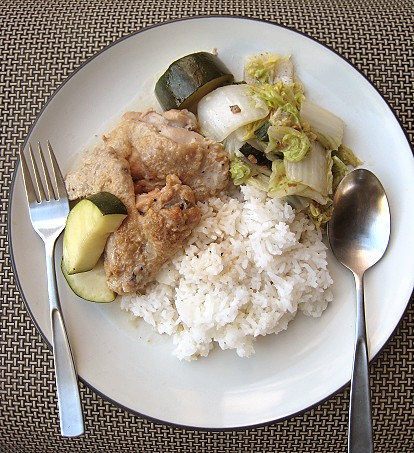
A proper Filipino meal: rice and ulam on a plate, with spoon and fork.
[js]
We're not big gata (coconut milk) people, so I can remember less than a handful of dishes that we eat involving coconut milk.
Ginataang manok (chicken cooked in coconut milk) is not one of them.
However, I had another cut-up chicken and I was running out of ideas and running out of time. We keep a couple of cans of coconut milk in the pantry, so I figure it was time to use them up and get new cans.
I started with recipe from LSC for a general sense of the technique involved.
Adobong Manok sa Gata (Chicken Adobo in Coconut Milk)
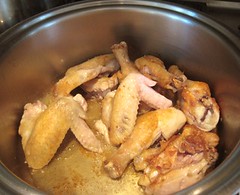 [js]
[js]
First, I browned the chicken in some oil. This is not a necessary step and I can also omit it, especially if one does not feel like cleaning up splatters that day. But I was looking for a hit today: I find the smell of chicken frying in fat just intoxicating. It really is one of the best smells.
After taking out the chicken pieces and the excess oil, I sautéed some ginger. I added too much vinegar when I was deglazing -- hence, the final dish was on the sour-ish spectrum. The tartness was not unpleasant: it reminds one of the zing of adobo.
Hence, I call this dish chicken adobo in coconut milk.
I added a couple of cans of coconut milk, a dozen or so peppercorns, and about 6 cloves of garlic, just lightly crushed, and a bay leaf. I let the mixture braise until the chicken is tender.
Salt and more pepper to taste, of course.
We had a couple of zucchinis lying around and it joined the chicken in the pot because it had no other place to go.
Cabbage with Mushroom Paste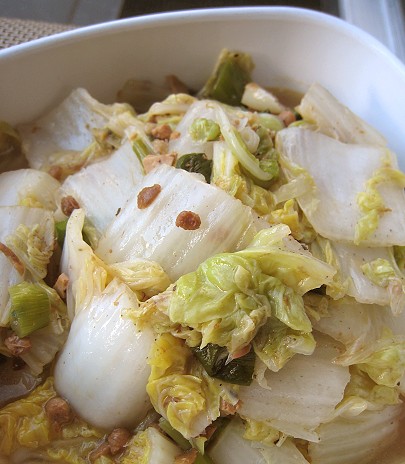
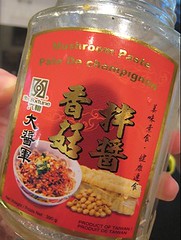 [js]
[js]
For a vegetable dish, I sautéed some napa cabbage with a "helper."
My mother loves to keep these mushroom pastes around for her minced pork dishes.
I used a couple of tablespoons, along with a couple of cloves of garlic, and let everything cook together. It wasn't really a stir-fry; rather, I let the cabbage braise until tender.
The Meal
[ts]
The chicken dish and the vegetable dish are ulam.
Ulam is often translated into English as a "viand". Basically, ulam are dishes that you eat with rice. The rice can be thought of as the base of your meal, with various ulam as the "condiment" to the rice.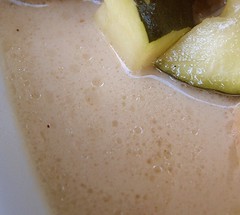 For a Filipino meal, you have your rice on the plate, you add your ulam (whatever it or they may be), and you eat the lot with your spoon and fork.
For a Filipino meal, you have your rice on the plate, you add your ulam (whatever it or they may be), and you eat the lot with your spoon and fork.
The spoon and fork setting is a Southeast Asian thing. Maybe someday we'll have a video of how to eat with the spoon and fork! =)
Look at that sauce from the chicken. Don't forget to spoon that over your rice!
So there you have it: simple, quick and easy, out-of-ideas cooking for a weeknight.
***Here is a version with halibut tails.
Enjoyed this post? Why not subscribe to our blog? Subscribe via reader or subscribe via email. Thank you! |
Recipe
Chicken Adobo in Coconut Milk (Adobo sa Gata)
Serves 4-6
1 whole chicken, cut up into pieces (or chicken parts)
2 cans coconut milk
1/2 cup apple cider vinegar (coconut vinegar or white vinegar)
6 cloves garlic
12 peppercorns
1 bay leaf
2" sliced ginger
salt
1. Season chicken pieces and brown chicken pieces in oil.
2. Drain excess oil except for 2 tablespoons.
3. Add ginger pieces and saute.
4. Add crushed garlic and saute until fragrant.
5. Deglaze with vinegar and add the coconut milk.
6. Put back chicken pieces, along with peppercorns and bay leaf.
7. Let mixture braise until chicken is tender.
eatingclub vancouver adobo posts:
Chicken Adobo
Pork Belly, Two Ways
Adobo Kangkong (Adobo Water Spinach)
Adobo Mushroom Tart
"Chinese Adobo" Clams and Oysters
Chicken Adobo in Coconut Milk (Adobo sa Gata)
Coconut Adobo Halibut Tails (Adobo sa Gata)
Roast Chicken Adobo
Brown-braised Pig's Feet
Adobong Baka (Philippine Beef Adobo)






No soy sauce? I thought adobo was the vinegar and soy sauce combo? I do like the sound of this dish though. I totally know what you mean about liking the smell of chicken frying. I had a chicken tom yum soup today and some of the chicken pieces were crispy fried. So good!
ReplyDeleteFunny when I think of adobo I always think of the Mexican sauce. Well that was until I saw Anthony Bourdain in the Philippines...this looks pretty darn comforting
ReplyDeleteI will have try this adobong na gata as it looks delicious and a great variation to the classic!
ReplyDeleteYou've done it again -- impromptu perfection. I'm thinking that mushroom paste was probably fabulous with the cabbage... not something I keep on hand, but I'm definitely rethinking that.
ReplyDeleteAm also rethinking Adobo. I'm with Kat; Latin food always comes to mind for me... but I've got to adjust my thinking.
This dish looks and sounds so flavourful!
ReplyDeleteWandering Chopsticks:
ReplyDeleteActually, I haven't heard of an adobo without soy sauce, either. Then I read the article in Saveur (December 2008, I believe) and there was a recipe for a non-soy sauce adobo! The woman who provided it was also saying that she believes hers is the authentic adobo! Hehe... So I guess no soy sauce is possible.
kat:
Lo:
The Philippine adobo is a less complicated taste, I believe. Just really punchy and bold, but simple.
(Haven't seen that episode of No Reservations! I think it may be a year before we get to. It's on syndication on Discovery Channel here. Of course, that's because we're not savvy looking for such things online.)
Joelen:
And good thinkg it wasn't too "gata-y" too. =)
Lo:
All those Chinese/Asian "pastes" are a mystery to us. We're just now starting to learn about them.
Dragon:
It has a lot of bang for the buck, flavor-wise. =D
I love love love coconut milk, some days I think I have a coconut milk deficiency. I like the idea of the extra vinegar and am curious how this would taste. And, thanks for the tip on mushroom paste -- I hadn't come across this before and will look for it!
ReplyDeleteI always wonder if the Filipinos have any local specialty dishes, great to learn one from you. Great that all these ingredients are accessible in Switzerland.
ReplyDeleteAllen:
ReplyDeleteThose Chinese/Asian bean pastes things and other pastes are still a mystery to us too!
Janet_Gourmet Traveller 88:
We have a lot of Filipino dishes on the blog! =)
That sauce is looking pretty damn good. Someone asked me once why Filipinos don't use chopsticks. What the?
ReplyDeleteJude:
ReplyDeleteHaha... Say, "We choose not to!" =D
There's a variety of Adobo in Bulacan, a province In Luzon, Philippines, that only uses vinegar, water, garlic, bay leaf and black pepper. It's really, really good. You don't taste the vinegar at all. It's also served in a local restaurant as "Adobong Sulipan", I've tried doing it and it tastes really really good. But for that one you have to use both chicken and pork and it's not as easy as just letting it all mix together, there's a process where you have to boil, remove sauce, fry and add the sauce again.
ReplyDeleteBeing part Filipino, adobo is a pretty popular dish in my home. Like the some of the other comments on this post, I am used to adobo with vinegar, soy sauce, bay leaf, garlic, and black pepper, but I must say that this sounds super yummy. I never would've thought to add coconut milk.
ReplyDeleteI agree, you could skip the frying part, and I have done that a couple of times that I made adobo, but it just wasn't the same. Thanks for sharing this different version of a Filipino classic.
Katwo:
ReplyDeleteWe should definitely try our hand at "other" adobos. Thanks for sharing this version!
Deseree:
Haha, we're mostly laszy and seldom fry up the chicken afterwards. Of course, fried is good... but in any case, the whole family still enjoys them, even unfried. =)
for a no-soy sauce adobo try to replace the soy sauce with twice the part of coconut water. ~ adobo blanco ;-) (no coconut milk this time)
ReplyDeleteP. Raimi, Ph.D.:
ReplyDeleteOh, oh, coconut water! Thanks for the great idea!